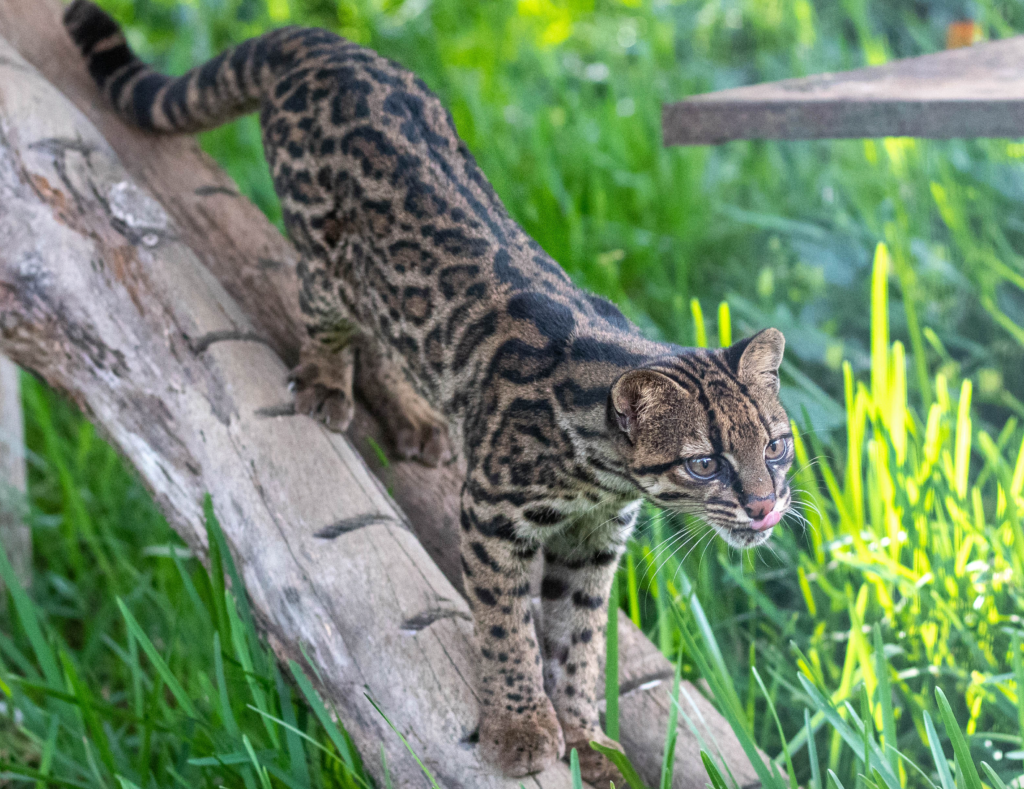by Conservation Project Director Megan Parker
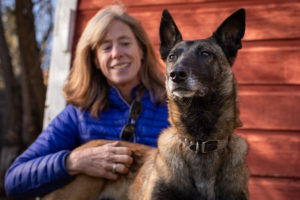
People who are cat people know that cats have their own agenda. People who are dog people recognize that dogs want to share their agendas with you. We get to mix these agendas when working a detection dog to find scat from an elusive cat in Costa Rica. In the high forests of this beautiful country, hide a suite of cat species—from jaguar and cougar, to ocelot, margay and jaguarundi. And while always there, but rarely seen, is a small, spotted, nocturnal cat called oncilla. So little is known of this cat, that their scat—or poop—holds precious genetic information that can help us learn more about this declining species, and well… dogs are good at finding hard-to-find things and telling us about it.
Finding animal scat gives us a wealth of information and, with a rare cat, can tell us a lot about what we need to do to preserve the forests where it lives and what risks it faces. The Center for Large Landscape Conservation provided support for recent field work in Costa Rica to learn more about these wild cats, the corridors they use, conservation planning with communities, and the threats that oncilla and other animals face from the roads fragmenting their habitat in this country. On this trip, we had critical assistance from our specially trained detection dog, Tule, to help find clues to understand where and how the oncilla lives.
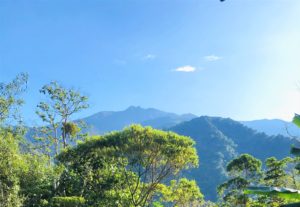
Oncillas (Leopardus tigrinis oncilla) have been seen by local people occasionally and are sometimes found hit by cars, along with other wildlife, on the many roads that snake through Costa Rica. Recently, camera traps have revealed that these cats, also called northern tiger cats, live in high elevation cloud forests, out of reach of most human visitors and larger predators. These are forests where little development has occurred, however the lower mountains and valleys are filled with risks to oncilla travelling between high mountain habitats.
In the spring of 2022, we traveled from Montana to Costa Rica to work with José Daniel Ramírez-Fernández. José runs the Oncilla Project for the Costa Rica Wildlife Foundation (CRWF)—a nonprofit focused on learning about and protecting the country’s wildlife and promoting citizens’ appreciation of their land and animals. He and his team are working across the country with collaborators to determine the range, food, habits, and requirements of oncilla and working with communities to help prevent conflicts, as oncilla do eat chickens.
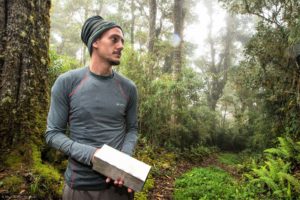
We had worked with José and his team in 2021, through Working Dogs for Conservation, to survey for oncilla scat with Tule. Due to early rains, we did find scats that year, but not as many as we hoped, due to many impassable trails. This year, we went as volunteers for the oncilla project and ambassadors for ecological connectivity for the Center. As in the year previous, Tule led surveys in areas across Costa Rica where José had camera traps set to capture images of oncilla, and where he determined were the best locations to collect scat.
Tule is trained to find fecal samples from oncilla and to ignore all the other tempting odors in the forest. These samples contain genetic information to help determine the differences between this oncilla and other cats in Latin America. Genetic information informs conservation planning in understanding the genetic diversity, size, and range of a population of rare species.
The realities of field work are far from glamorous, and this trip began with a long drive from Missoula, Montana, to Seattle, to board a plane that can fly dogs as luggage. In 2021, we had hit an early rainy season and the ridiculously steep trails were muddy, scats were washed away or soggy, and hiking conditions were difficult and sometimes impossible. This year, we arrived a month earlier and found some areas dry and conditions great for hiking and keeping precious scat samples intact.

We flew all day, landed in San Jose, and left early the next morning to drive south, near the Panama border, where oncilla have been seen on cameras and by landowners. These cats live at higher elevations in intact forest where small rodents and birds are abundant, and where larger cats that compete or prey upon them are scarce. José directed us to high-elevation forests where we could hike up trails into cloud forest and follow Tule, who worked to find the scent of oncilla scat as she moves through the jungle.
When Tule encountered the scent, we stopped to watch her tail wag purposefully and her breathing increase into deep huffing breaths until she pinpointed the scat with her nose, then sat and stared to get her reward—a ball to play with, and love and gratitude from the team. Then José would move in and look through the leaf litter to find a small, camouflaged scat which he collected and puts into vials to preserve for shipping to a genetic lab. This year Tule found nearly 20 scats, which is a bonanza of potential information.
In addition to looking for this mythically rare cat, the Costa Rica Wildlife Foundation also conducts studies and develops conservation action plans for quetzals, tapirs, and manatees, and community habitat restoration projects to reconnect severed landscapes and reduce human-wildlife conflict, including vehicle collisions. These are the arenas where the Center excels and can help partners like CRWF apply best practices that have successfully bridged conflicts between people and wildlife. This expertise is one reason the Center provides leadership for the Latin American and Caribbean Transport Working Group, an international group of wildlife and transportation professionals helping reduce risks to wildlife on roads and rail lines.
The Transport Working Group, part of IUCN’s Connectivity Conservation Specialist Group, is focused on reducing wildlife mortality and making transportation systems more permeable for animal movement throughout Latin America and the Caribbean. This group’s work has helped lead to Costa Rica and other Latin American countries installing wildlife crossings and enacting legislation that provides protection for biological corridors.
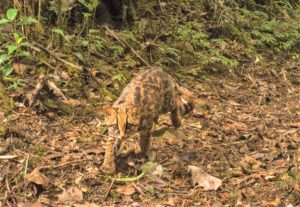
Costa Rica is a shining example of a country creating new laws where conservation is needed. Their corridors are mandated to “restore ecological connectivity and re-establish ecological processes on lands subject to different tenure and types of use, establishing a participatory process involving all local actors.” Costa Rica has implemented biological corridors since 1990, with the creation of the Talamanca-Caribe Corridor. The process to establish biological corridors as a strategy for the conservation and restoration of biodiversity was a visionary move, started in 2006, with the establishment of the National Bio-Corridor Program.
It was a singular pleasure to be in a country where approximately 28% of the land is protected in national parks, and where private landowners are encouraged to restore forests and protect land and water, adding another 26% of lands protected for nature. This region, with a very high degree of biodiversity and species richness, is exemplary in improving connectivity and reducing conflict across the landscape, making a viable home to incredible wildlife, including an elusive, small, spotted cat we hope to learn a lot more about.
Photo, above post: The only oncilla living in a captive facility in Costa Rica. ©Zara Palmer – Toucan Rescue Ranch/CRWF. All other photos courtesy of Megan Parker unless otherwise indicated.
